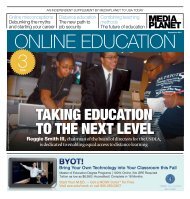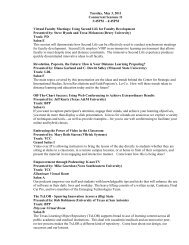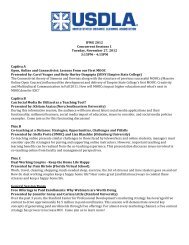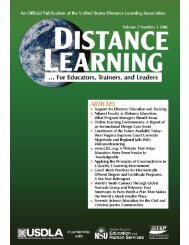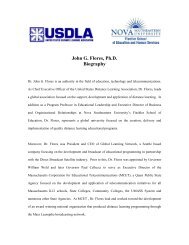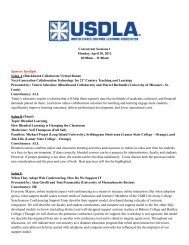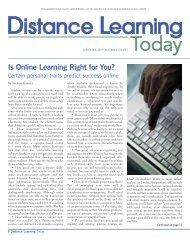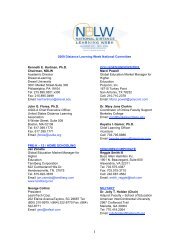United States Distance Learning Association
United States Distance Learning Association
United States Distance Learning Association
- No tags were found...
You also want an ePaper? Increase the reach of your titles
YUMPU automatically turns print PDFs into web optimized ePapers that Google loves.
own graduate experience as being face-toface<br />
intensive with her advisor and peers.<br />
She said, “I really enjoyed those times<br />
when I could go by his office and just sit<br />
and speak with him about my topic. Also I<br />
remember that often a group of us would<br />
sit in his office and have great conversation.”<br />
In light of these experiences, she naturally<br />
would have ambivalence about<br />
interacting only in a virtual environment<br />
in that it may take away from the richness<br />
of the experience. She clearly was much<br />
more tied to this concept of a live presence<br />
than the other professor. Perhaps that<br />
would wane as she became more experienced<br />
in teaching. This would be something<br />
to note in selecting professors for<br />
using this technology. The more experienced<br />
faculty may not have such a strong<br />
need for a face-to-face presence with their<br />
students. It would be expedient to gauge<br />
their attitudes around having a face-toface<br />
or virtual presence.<br />
COMPLEXITY<br />
The perceived complexity of Live Classroom<br />
became compounded when many<br />
faculty thought that they had to learn how<br />
to teach in a fully online course to use this<br />
technology. However, some professors<br />
modified the use of Live Classroom to<br />
record and archive their lectures in the<br />
face-to-face classroom. This would have<br />
been a good strategy to suggest for the<br />
entire faculty. Using it this way would<br />
have provided a bridge to allow them to<br />
get comfortable with the technology and<br />
master it in stages.<br />
The complexity of Live Classroom was<br />
mitigated by the full support and training<br />
offered to the faculty by CLTT. Having<br />
instructional and technical support<br />
allowed them to relax and concentrate on<br />
their teaching. It is essential that in considering<br />
diffusion of new technology that the<br />
complexity factor is reduced to a minimum.<br />
TRIALABILITY<br />
Both faculty members had the opportunity<br />
to experiment with Live Classroom<br />
and did not have to make a decision for<br />
full-scale adoption immediately. This was<br />
helpful for the junior faculty member who<br />
was more hesitant in delivering her course<br />
off-site. If she had not been given this<br />
opportunity to test it in a modified way,<br />
she might not have engaged with it at all.<br />
OBSERVABILITY<br />
There was nothing tangible to observe in<br />
terms of results of the use of this technology.<br />
However, the Center did donate tablet PCs<br />
to those faculty using Live Classroom for<br />
the semester. Other faculty inquired about<br />
their new laptops, which initiated the discussion<br />
of Live Classroom. It is important to<br />
try to provide something concrete in relation<br />
to new technology usage.<br />
COMMUNICATION CHANNELS<br />
The rate of adoption of an innovation is<br />
measured by the number of individuals<br />
over a specific period of time who adopt<br />
the innovation (Rogers, 1995). Communication<br />
channels, either mass media or<br />
interpersonal, will influence this rate.<br />
However, the communication channel<br />
needs to be used strategically depending<br />
on the stage of adoption. For example, in<br />
the early stages of diffusion, the innovation<br />
is picked up by early adopters. Rogers<br />
(1995) developed five adopter categories<br />
that provide useful information when<br />
framing the diffusion process for a new<br />
technology. They consist of innovators,<br />
early adopters, early majority, late majority,<br />
and laggards. These categories provide<br />
a structure for audience segmentation and<br />
different communication channels can be<br />
selected for the target audience.<br />
Rogers’ (1995) framework suggests that<br />
the process of diffusion begins with the<br />
innovators. In this case, the innovator was<br />
a department (CLTT) rather than an individual.<br />
This allowed for control of financial<br />
resources and was helpful in assuming the<br />
Volume 4, Issue 4 <strong>Distance</strong> <strong>Learning</strong> 51



